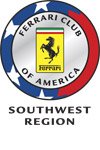
Oldtimer's Corner - So Cal Racing in the 1950's
By: Ed Niles
Jeff has asked me to write about the Ferrari culture, dealers, owners, and racers of the 50?s and 60?s. But first, where did all that racing take place?
At the end of World War II, most of us were relegated to going to Gilmore Stadium (Beverly and Fairfax) on Thursday nights to watch the midgets on that great old 1/4 mile dirt track. Of similar ilk was Carrell Speedway, which began to accommodate a few sports car events, mostly featuring Jaguars and MGs of around 1950 vintage. But with the sports car owners and drivers multiplying like rabbits turned loose in Aunt Tessie?s backyard, these venues rapidly became inadequate. Officials of the SCCA and the Cal Club (remember from last month?s Sempre Ferrari?) soon started working their magic to appropriate parts of public airports and parks to lay out so-called road courses. Examples of well-tested courses that survived for many years on airport runways were Santa Barbara, Santa Maria, Palm Springs, and Glendale. (Yes, Virgina, there was actually a Glendale airport, now an industrial park, West of Colorado Blvd. and San Fernando Road.)
Temporary race courses were also designed to fit into the topography of other semi-public and private properties, including the Pomona Fair Grounds, Stardust International Raceway behind the Stardust Hotel in Las Vegas, Torrey Pines located in a park near La Jolla, and Paramount Ranch in the Augora Hills area. Finally, purpose-built race courses eventually showed up at Willow Springs (still in existence in the Antelope Valley), Riverside Raceway (now a residential development), and Ontario Motor Speedway (which has also been redeveloped into residential property).
It is hard to realize, in this day when there is such a paucity of race courses, that the great number and variety of venues was a part of what made sports car racing so exciting in the 50?s and 60?s. At one time, there were at least a dozen active race courses being used within a few hour?s drive of Los Angeles.
Willow Springs, Palm Springs, and to some extent Stardust, Ontario and Riverside, had a common feature: It was either blazing hot or freezing cold, and when the wind blew there would be sand in every orifice or car and man alike. As a former Turn Marshal, I can tell you that there were not enough clothes to protect one who had to stand out on a lonely corner for an entire weekend when the wind was blowing at Palm Springs.
Back in the days when the drivers were fat and the tires were skinny, we were slow learners. If there was something we could do to lay out a race course so as to make it unsafe, we did it, with innocent alacrity. Especially on the airport courses, which were for the most part flat, the courses were laid out by injudicious placement of hay bales and snow fencing. Try to picture a little wire and a few slats of wood stopping a 1500 pound out-of-control vehicle and you?ll get the picture. Hardly a race weekend passed without several serious accidents, often involving injuries to drivers or sometimes to workers or spectators. It soon became apparent even to the slowest of us that snow fencing was not much help. The hay bales, which started out being placed two or three at each corner, soon were stacked double high and triple thick around the outside of each corner.
There seems to have been an unwritten rule that we would not speak of these accidents outside of our little circle, and that the automotive press would play them down. But now, with the perspective of decades, it is easy to see that our IQs were no greater than our waistlines when it can to safety considerations. I can?t tell you how many injuries and fatalities I have witnessed which could have been prevented under current-day thinking.
A few examples: At Pomona, I once saw the driver of one of the many iterations of "Ol? Yeller" lose it on the exit to the first ha
For a complete look at Sempre Ferrari, you may want to check out the rest of the articles from Volume 2, Issue 2 - February 1995
